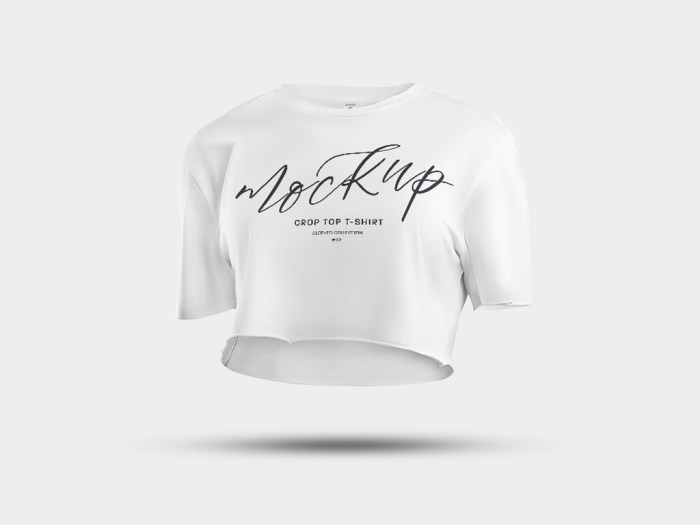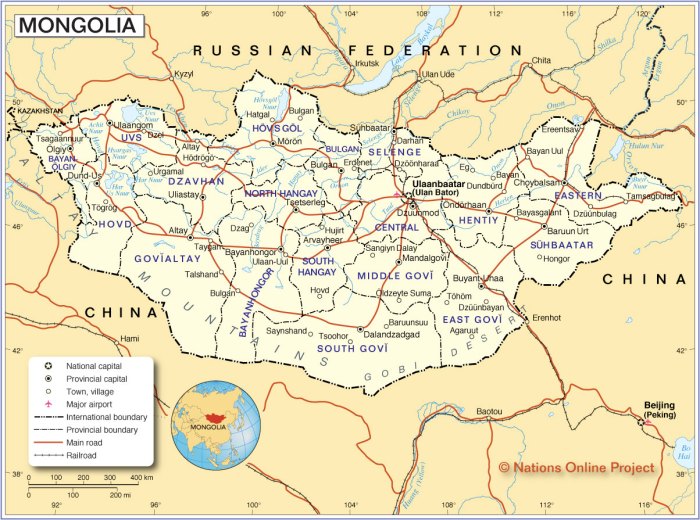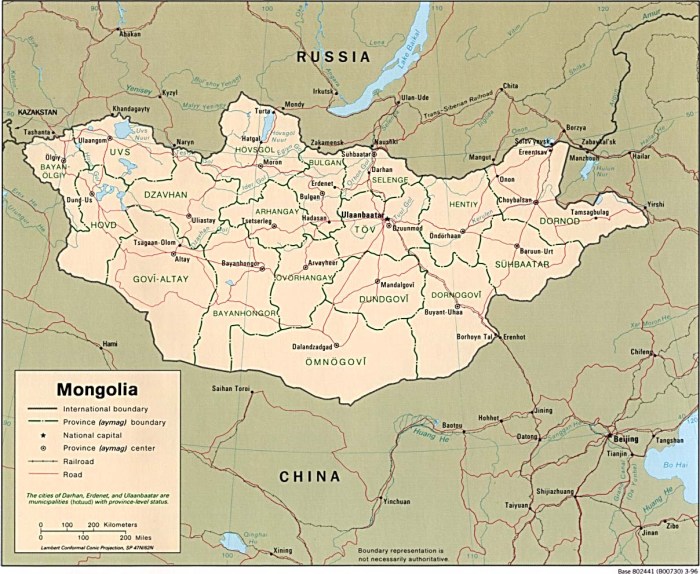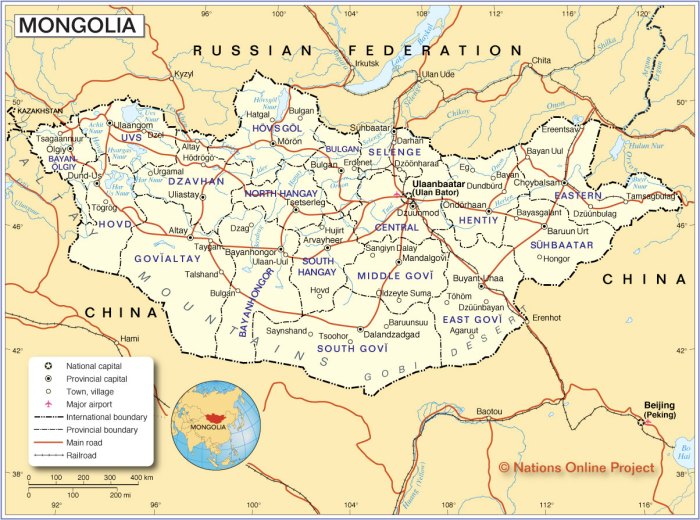Top things to do in Mongolia: Embark on a captivating journey through the breathtaking landscapes and rich culture of this unique Asian country. From exploring ancient sites to experiencing nomadic life, Mongolia offers an unforgettable adventure for every traveler. Discover the best places to visit, the must-try activities, and essential tips for planning your Mongolian expedition.
Mongolia’s diverse terrain, from towering mountains to vast grasslands, promises thrilling outdoor activities. Immerse yourself in the fascinating nomadic traditions and experience the hospitality of the Mongolian people. This comprehensive guide will unveil the top attractions and offer practical information to make your trip truly exceptional.
Introduction to Mongolia
Mongolia, a landlocked country nestled between Russia and China, boasts a captivating blend of history, culture, and breathtaking landscapes. From the vast steppes to the towering Altai Mountains, Mongolia offers a unique travel experience unlike any other. Its nomadic heritage, rich in tradition and resilience, intertwines with modern-day opportunities for adventure and exploration. This land of contrasts beckons travelers seeking authentic experiences, offering a glimpse into a world that has endured for centuries.Mongolia’s unique appeal lies in its ability to bridge the gap between ancient traditions and modern-day adventures.
Its open spaces, rugged terrain, and vibrant culture create a compelling draw for travelers. Whether you seek thrilling outdoor activities, immersive cultural immersion, or a serene escape into nature, Mongolia offers something for every traveler. The country’s diverse tourism offerings cater to a wide range of interests, from horseback riding through the heart of the Mongolian steppe to exploring ancient monasteries and interacting with the local people.
Mongolia’s History and Culture
Mongolia’s history is deeply intertwined with its nomadic heritage. For centuries, the Mongolian people have thrived on the vast steppes, adapting to the harsh environment and preserving their unique culture. Genghis Khan, a pivotal figure in Mongolian history, united the nomadic tribes and forged a vast empire, leaving an enduring legacy. Today, Mongolia’s cultural traditions are still alive and well, expressed through music, dance, and the artistry of the nomadic way of life.
Traditional Mongolian clothing, often adorned with intricate embroidery and vibrant colours, serves as a visual representation of this rich cultural heritage. The country’s unique nomadic lifestyle is still practised by many Mongolians, offering travelers a chance to witness a way of life that has endured for generations.
Geographic Features
Mongolia’s geography is as diverse as its culture. The country’s landscape ranges from the arid Gobi Desert, with its dramatic sand dunes and sparse vegetation, to the towering peaks of the Altai Mountains, home to glaciers and pristine alpine meadows. The vast steppes, rolling grasslands stretching to the horizon, are a testament to Mongolia’s vastness and beauty. The country’s diverse topography creates a range of stunning natural wonders, from the impressive Khongoryn Els sand dunes to the tranquil lakes and rivers that dot the landscape.
These varied landscapes offer opportunities for a wide array of outdoor activities.
Types of Tourism Experiences
Mongolia offers a multitude of tourism experiences to cater to various interests. For those seeking adventure, Mongolia offers horseback riding tours through the picturesque steppes. For those who prefer a more relaxed pace, exploring the ancient monasteries and interacting with the local communities is a rewarding experience. Cultural tours provide an in-depth look at the country’s traditions and customs.
For those seeking solitude, hiking in the mountains or camping under the star-studded Mongolian sky is a perfect way to immerse in the natural beauty of the land. Visitors can participate in various activities, from witnessing traditional Mongolian wrestling and horse racing to taking part in cultural performances.
Example of a Mongolia Itinerary
- Day 1-3: Arrive in Ulaanbaatar, explore the city, visit museums, and take a guided walking tour.
- Day 4-6: Embark on a horseback riding adventure through the Mongolian countryside, experiencing the unique landscape and nomadic lifestyle.
- Day 7-9: Visit the Gobi Desert, explore the stunning sand dunes, and experience the unique desert ecosystem.
- Day 10: Return to Ulaanbaatar, depart from Mongolia.
This itinerary provides a concise example of the variety of experiences Mongolia offers.
Iconic Tourist Attractions
Mongolia, a land of vast steppes, towering mountains, and ancient history, boasts a wealth of captivating tourist destinations. From the breathtaking landscapes to the rich cultural heritage, exploring these sites offers a profound insight into the soul of this unique nation. These attractions provide opportunities to witness the country’s resilience, its connection to the past, and its vibrant present.Exploring these iconic destinations allows visitors to connect with Mongolia’s enduring spirit and experience its profound cultural heritage firsthand.
Top 5 Most Famous Tourist Destinations
Mongolia’s appeal extends far beyond its striking scenery; it’s a nation deeply rooted in history and culture. These five destinations showcase this richness in tangible ways.
- Gobi Desert: This vast, arid landscape stretches across southern Mongolia, offering a unique glimpse into the harsh beauty of the Eurasian steppe. The Gobi Desert boasts ancient rock formations, fossils, and nomadic herding communities that have adapted to its challenging environment for centuries. Visitors can experience camel treks, jeep safaris, and overnight stays under the starlit sky.
- Khongoryn Els: This breathtaking valley, often described as “the Valley of the Moon,” is known for its stunning sand dunes, crystal-clear lakes, and vibrant grasslands. The Khongoryn Els area has an exceptional cultural significance, as it has been a historical pathway for nomadic tribes and is home to a unique biodiversity. Visitors can experience horseback riding, camping, and exploring the local wildlife.
The area’s pristine beauty offers breathtaking photo opportunities.
- Erdene Zuu Monastery: A significant Buddhist temple complex, Erdene Zuu Monastery is a testament to Mongolia’s rich spiritual heritage. This historical site holds immense cultural importance as a center of Mongolian Buddhism for centuries. Visitors can explore the monastery’s architecture, witness traditional Buddhist ceremonies (if available), and learn about the monastery’s historical significance. It’s a great opportunity to experience Mongolian religious traditions.
- Terelj National Park: Nestled in the foothills of the Khangai Mountains, this park is renowned for its scenic beauty and diverse landscapes. It features towering mountains, picturesque valleys, and pristine forests. The park’s historical significance lies in its connection to the nomadic traditions of Mongolia. Visitors can enjoy hiking, horseback riding, and wildlife spotting. It’s a perfect destination for nature enthusiasts.
- Ulaanbaatar: Mongolia’s capital city, Ulaanbaatar, is a blend of modernity and tradition. It offers a glimpse into Mongolia’s urban life while maintaining its cultural heritage. The city’s historical significance lies in its role as the political and economic center of Mongolia. Visitors can explore the city’s museums, temples, and markets, experiencing a dynamic blend of history and the present.
This is an ideal destination for experiencing urban Mongolia and its blend of culture and modernity.
Must-See Attractions for First-Time Visitors
For first-time visitors, focusing on a few key attractions is crucial for a memorable experience. The destinations listed below offer a diverse range of experiences, from stunning landscapes to rich cultural immersion.
- Gobi Desert: Explore the ancient landscapes, witness the resilience of nomadic communities, and experience the unique beauty of the desert.
- Khongoryn Els: Immerse yourselves in the breathtaking beauty of the sand dunes and the surrounding landscapes.
- Erdene Zuu Monastery: Discover the rich history and cultural significance of this important Buddhist temple.
- Terelj National Park: Enjoy the stunning natural beauty and immerse yourselves in the cultural heritage of the nomadic traditions.
- Ulaanbaatar: Explore the capital city’s vibrant markets, museums, and temples, experiencing a blend of history and modernity.
Typical Activities and Experiences
These destinations offer a variety of activities and experiences, catering to different interests and preferences.
- Gobi Desert: Camel treks, jeep safaris, exploring ancient rock formations, and interacting with local communities.
- Khongoryn Els: Horseback riding, camping, and experiencing the stunning landscapes.
- Erdene Zuu Monastery: Visiting the temple, learning about Mongolian Buddhism, and experiencing traditional ceremonies.
- Terelj National Park: Hiking, horseback riding, and observing local wildlife.
- Ulaanbaatar: Exploring museums, visiting temples, exploring markets, and experiencing the vibrant city life.
Comparison Table
| Attraction | Travel Time | Cost | Difficulty |
|---|---|---|---|
| Gobi Desert | 4-7 days (depending on location) | Moderate to High | Moderate (Requires planning and potentially some challenging terrain) |
| Khongoryn Els | 2-4 days (depending on tour) | Moderate to High | Moderate (Requires some physical activity) |
| Erdene Zuu Monastery | 1-2 days (depending on travel route) | Low to Moderate | Low (Easy access and transportation) |
| Terelj National Park | 1-2 days (depending on tour) | Moderate | Low (Accessible by car or guided tour) |
| Ulaanbaatar | Variable (depending on mode of transport) | Low to Moderate | Low (Easy to navigate and access) |
Nature and Outdoor Activities
Mongolia’s breathtaking landscapes, from towering mountains to vast steppes, offer an unparalleled outdoor adventure experience. The country’s unique ecosystems teem with wildlife, and a variety of activities cater to different interests, from seasoned hikers to those seeking a more relaxed exploration. Whether you’re yearning for adrenaline-pumping horseback rides or peaceful moments amidst nature, Mongolia has something to offer every traveler.The vastness and diversity of Mongolia’s natural environments create an exciting and immersive experience for visitors.
From the dramatic peaks of the Altai Mountains to the undulating grasslands, the country’s landscapes provide a stunning backdrop for outdoor pursuits. This diverse terrain supports a rich tapestry of wildlife, making it a haven for nature lovers.
Diverse Landscapes
Mongolia’s landscapes showcase a remarkable diversity. The country is home to towering mountain ranges, such as the Altai and Khangai Mountains, featuring jagged peaks and snow-capped summits. Vast stretches of grasslands, dotted with nomadic herders’ yurts, stretch out as far as the eye can see. The Gobi Desert, with its unique geological formations and sparse vegetation, presents a starkly different environment.
These contrasting landscapes provide ample opportunities for exploring different ecosystems. The variety in topography allows visitors to experience a spectrum of environments in a single trip.
Wildlife Encounters
Mongolia is a sanctuary for a variety of wildlife. Visitors can spot the majestic snow leopard, elusive in its mountain habitat. The steppes are home to the wild horse, the symbol of the country, as well as various species of birds. The Gobi Desert supports reptiles, hardy mammals, and specific bird species adapted to arid conditions. Many nature reserves offer guided tours and wildlife spotting opportunities.
For example, the Terkhiin Tsagaan Nature Reserve offers a unique chance to observe the wildlife in its natural habitat.
Outdoor Activities
A wide array of outdoor activities cater to different preferences and levels of experience. Horseback riding through the grasslands provides a unique perspective on the Mongolian landscape and immerses you in the culture. Hiking through the mountains allows for breathtaking views and physical exertion. Camping under the vast Mongolian sky offers a chance to connect with nature and experience the serenity of the wilderness.
Exploring Mongolia’s stunning landscapes and nomadic culture is a must-do. From the vast Gobi Desert to the majestic mountains, there’s so much to see. Thinking about the architectural wonders of the world, you can’t miss the historical significance of the Hagia Sophia Istanbul mosque, hagia sophia istanbul mosque , a true testament to human ingenuity. Ultimately, Mongolia offers a unique blend of adventure and history, making it a truly unforgettable travel destination.
Activities for Different Travelers
Different outdoor adventure options cater to various traveler types. Experienced hikers and mountaineers can explore challenging trails in the mountains, while families can enjoy gentler hikes and horseback rides. Nature photographers can capture stunning landscapes and wildlife. Camping trips can be tailored to suit different comfort levels, ranging from basic to luxury accommodations within nature reserves. The flexibility of Mongolia’s outdoor experiences caters to the diverse needs of visitors.
A Typical Mongolian Nature Reserve
A typical Mongolian nature reserve, such as the Hustai National Park, encompasses diverse landscapes. It often includes designated camping areas, equipped with facilities like restrooms and water sources. The reserve may have marked hiking trails of varying difficulty. Guided tours are frequently available to help visitors learn about the local flora and fauna. These reserves play a vital role in protecting Mongolia’s natural heritage.
A nature reserve acts as a protected area preserving the environment and the unique wildlife it supports. The conservation efforts in these areas contribute to the preservation of Mongolia’s rich biodiversity.
Culture and Traditions
Mongolia’s rich tapestry of culture is deeply interwoven with its nomadic heritage. The resilience and adaptability of the Mongolian people are reflected in their traditions, which have endured for centuries, often unchanged by modern influences. Their profound connection to the land, a vital part of their spiritual and social fabric, shapes their daily lives and cultural expressions.The nomadic lifestyle, integral to Mongolian identity, has profoundly influenced their cultural practices.
This way of life, demanding a deep understanding of the land’s resources and rhythms, has fostered a unique appreciation for nature and sustainability. This intricate connection to the environment is visible in their art, music, and ceremonies.
Nomadic Lifestyle and its Significance
The nomadic lifestyle is more than just a way of life; it’s a philosophy deeply ingrained in Mongolian culture. Generations have lived in close harmony with the vast steppe, moving seasonally to follow grazing pastures. This constant migration has shaped their understanding of the land’s cycles and fostered a profound respect for its resources. The ability to adapt to unpredictable weather patterns and limited resources is a hallmark of this tradition.
This intimate connection to the land is evident in their architecture, clothing, and even their language, all reflecting the cyclical nature of their existence.
Mongolian Language and its History
The Mongolian language, belonging to the Mongolic branch of the Altaic language family, possesses a rich history. It has influenced other languages in the region and boasts a vast oral tradition. Ancient texts, such as the Secret History of the Mongols, demonstrate the linguistic and historical significance of the language. The language, rich in poetic imagery and evocative descriptions of nature, embodies the spirit of the Mongolian people.
Modern Mongolian, while influenced by Russian and other languages, retains its unique characteristics and historical roots.
Traditional Ceremonies and Celebrations
Mongolian ceremonies and celebrations are deeply rooted in spiritual beliefs and traditions. Many ceremonies are dedicated to honoring ancestors, celebrating seasonal changes, and welcoming new life. These rituals, often incorporating music, dance, and storytelling, are integral to maintaining social harmony and cultural continuity. The Naadam festival, a national celebration of sport and culture, is a vibrant showcase of these traditions.
Mongolian Dress and Attire
Traditional Mongolian attire, often made from wool, reflects the harsh climate and nomadic lifestyle. The clothing, designed for both practicality and warmth, showcases the resourcefulness and artistry of the Mongolian people. The distinctive deel, a long robe, is a key element of this attire. Variations in design and ornamentation reflect different regions and social standing, providing insight into the diverse facets of Mongolian culture.
Accommodation and Food
Mongolia offers a diverse range of accommodation options, from traditional ger camps to modern hotels, catering to various budgets and preferences. The local cuisine, deeply rooted in nomadic traditions, is a vibrant tapestry of flavors, incorporating readily available ingredients like meat, dairy, and grains. Dining experiences in Mongolia range from casual meals in family-run restaurants to more formal settings in upscale establishments.The availability of accommodation and food varies significantly across Mongolia’s diverse regions.
Urban areas typically boast a wider selection of hotels and restaurants, while rural areas often rely on more basic, yet charming, traditional lodging and local eateries. This diversity reflects the country’s rich cultural heritage and the distinct lifestyles of its people.
Accommodation Options
Different accommodation options reflect the varying landscapes and experiences available in Mongolia. From the bustling cities to the serene countryside, you’ll find a variety of choices to suit your needs and preferences. Traditional gers, the iconic felt tents, provide a unique and authentic cultural immersion, especially popular for those seeking a deeper connection with nomadic life. Hotels and guesthouses, often found in major tourist destinations, provide modern amenities and comfort.
For a more luxurious experience, resorts and eco-lodges cater to travelers seeking a blend of comfort and natural beauty. The choice of accommodation will ultimately depend on your budget and the type of experience you desire.
Local Cuisine
Mongolian cuisine is heavily influenced by its nomadic past and the availability of local ingredients. A core part of Mongolian culinary traditions involves using readily available ingredients, with a focus on hearty and filling meals to sustain the nomadic lifestyle. Meat, particularly mutton and horse meat, is a staple. Dairy products like yogurt, cheese, and milk play a significant role in Mongolian cuisine, providing a source of protein and nutrients.
Grain-based dishes like dumplings, breads, and noodles are also essential parts of the diet.
Dining Experiences
Dining in Mongolia offers a diverse range of experiences, reflecting the country’s varied landscapes and cultures. Traditional family-run restaurants often provide a warm and welcoming atmosphere, allowing visitors to interact with local communities and learn about their culinary traditions. Modern restaurants and cafes, particularly in urban areas, cater to international tastes, offering a broader range of cuisines and options.
Nomadic-style dining experiences, such as those in ger camps, offer a chance to immerse yourself in the unique culture of the country, savoring meals in the heart of nature.
Popular Mongolian Dishes, Top things to do in mongolia
- Khorkhog: A hearty stew made with mutton, onions, and spices. It’s a quintessential Mongolian dish, often cooked over an open fire, providing a robust and flavorful meal.
- Buuz: These savory steamed dumplings, filled with meat or vegetables, are a popular street food and a common sight in local markets and eateries.
- Tsagaan Mal: A creamy yogurt dish, often served with meat or vegetables, highlighting the importance of dairy in Mongolian cuisine.
- Airag: A fermented mare’s milk drink, a traditional Mongolian beverage. It has a slightly sour taste and a creamy texture. This fermented drink is often associated with traditional nomadic life and offers a unique taste experience.
- Khuushuur: Crispy fried pastries, usually filled with meat, are a popular snack or side dish.
Accommodation Experiences in Different Regions
- Urban Areas: Hotels and guesthouses are prevalent in urban centers, providing modern amenities and a variety of dining options. These urban areas are generally more developed, providing a broader range of accommodation choices.
- Rural Areas: Traditional gers are commonly available in rural areas, offering a more immersive and authentic experience with the local community. Accommodation options are typically more basic, but provide a unique insight into the nomadic lifestyle.
- Nature Reserves/National Parks: Eco-lodges and campsites are prevalent in national parks and nature reserves, allowing visitors to experience the beauty of the landscapes while staying connected with nature.
Practical Information for Travelers
Embarking on a Mongolian adventure requires careful preparation. Understanding the practicalities of travel, from necessary documents to transportation options, will ensure a smooth and enjoyable journey. This section provides key information for a successful trip to Mongolia.Navigating a new country, especially one with a distinct culture and environment, demands careful consideration of essential details. This section details the practicalities, empowering travelers with the knowledge to prepare thoroughly and experience Mongolia to the fullest.
Travel Documents and Visas
Obtaining the necessary travel documents and visas is crucial for entering Mongolia. Visitors need a valid passport, with a minimum validity period exceeding the intended stay. Most nationalities can obtain a visa on arrival, but it’s advisable to check the specific requirements based on your citizenship before departure. Visa requirements are regularly updated; thus, consulting the official Mongolian embassy website is recommended.
Local Currency and Exchange Rates
The official currency of Mongolia is the Mongolian Tugrik (MNT). Exchange rates fluctuate, and it’s recommended to check current rates before departure. While credit cards are accepted in major cities and tourist areas, it’s always prudent to carry some cash, especially for smaller transactions or in less populated regions. Exchanging currency at reputable exchange bureaus is recommended to avoid potential issues with exchange rates or fraud.
Local Communication Methods and Internet Access
Mobile phone networks are widely available in Mongolia, with both local and international roaming options. Internet access is improving in urban areas, though availability in rural areas may vary. While Wi-Fi is becoming more prevalent in hotels and tourist sites, carrying a portable Wi-Fi device or international roaming data plan might be helpful for reliable internet access throughout your trip.
Transportation Options
Mongolia offers various transportation options. Domestic flights connect major cities, providing a faster way to traverse long distances. For a more immersive experience, consider hiring a 4×4 vehicle and a driver for exploring the countryside, experiencing the vast landscapes and interacting with locals. Alternatively, buses are a cost-effective option for traveling between cities and towns. It’s important to research transportation options and book in advance, especially during peak seasons.
Safety Considerations
Ensuring personal safety is paramount during any trip. While Mongolia is generally safe, travelers should be aware of their surroundings, particularly in isolated areas. It’s advisable to inform someone of your itinerary and estimated return time. Staying alert, being mindful of personal belongings, and avoiding risky situations will contribute to a safe and enjoyable experience. Respecting local customs and traditions is essential to avoid any misunderstandings or conflicts.
Exploring Mongolia is amazing! From nomadic culture to breathtaking landscapes, there’s so much to see. But, if you’re planning a trip, you might also be curious about travel efficiency, like TSA wait times. Modernizing airport processes like tsa wait times technology can make a huge difference in your overall trip experience, and it’s something to consider when you’re researching your Mongolian adventure.
Luckily, Mongolia offers stunning sights and experiences that will make your trip worthwhile.
Carrying necessary first-aid supplies and staying hydrated are also crucial aspects of safety planning.
Tips for Planning a Trip
Embarking on a Mongolian adventure requires careful planning. This meticulous process ensures a smooth journey, maximizing your enjoyment and respecting the unique culture and environment. Thorough preparation allows you to appreciate the stunning landscapes and engaging experiences Mongolia offers.Understanding the best time to visit, necessary gear, and cultural nuances is key to a memorable trip. A well-structured itinerary, coupled with an awareness of budget considerations, will significantly enhance your overall experience.
Crafting Your Itinerary
Planning your journey involves meticulous preparation. Start by defining your interests and desired experiences. Do you prefer exploring bustling cities, immersing yourself in nomadic culture, or challenging yourself with outdoor adventures? Once you have a sense of what you want to see and do, research specific locations and activities that align with your preferences. For instance, if you’re passionate about wildlife viewing, researching national parks and reserves will be essential.
Optimal Travel Timing
Mongolia’s diverse landscapes and activities cater to different travel styles, dependent on the time of year. Spring (April-May) and autumn (September-October) are generally the best times to visit. Spring offers blooming wildflowers and pleasant weather, while autumn showcases vibrant foliage and crisp air, ideal for hiking and exploring. Summer (June-August) is hot and sunny, but perfect for experiencing the nomadic lifestyle firsthand.
Winter (November-March) presents a unique opportunity to witness the country under a blanket of snow, though the weather can be harsh and some areas may be inaccessible.
Essential Gear for Various Activities
Mongolia’s diverse activities demand appropriate gear. For trekking and hiking, sturdy hiking boots, layers of clothing (including a waterproof jacket), and a backpack are crucial. If you plan to ride horses, comfortable riding gear, including riding boots and a helmet, is essential. For wildlife viewing, binoculars or a spotting scope will enhance your experience. If you’re visiting in winter, warm layers, including thermal underwear, a warm coat, and insulated boots, are paramount.
Budgeting for Your Mongolian Adventure
Mongolia’s costs vary depending on your choices. Accommodation, food, transportation, and activities all contribute to the total cost. Budgeting meticulously will allow you to enjoy your trip without unnecessary financial strain. Accommodation ranges from budget-friendly guesthouses to luxurious hotels. Food can be surprisingly affordable, with opportunities to experience traditional Mongolian cuisine at reasonable prices.
Transportation costs vary depending on the method chosen (private vehicle, organized tours, or public transportation). Consider factoring in the costs of activities like horse riding or trekking when planning your budget.
Cultural Sensitivity in Mongolia
Respecting local customs is vital for a positive travel experience. Mongolia has a rich cultural heritage, and demonstrating respect is important. When visiting homes or interacting with locals, appropriate attire, such as modest clothing, is recommended. Ensure that you are aware of and respect the importance of personal space and etiquette when engaging with the locals. Learning a few basic Mongolian phrases will be greatly appreciated by the people you meet.
Be mindful of local customs and traditions, and try to engage with the culture respectfully and thoughtfully.
Alternative Activities

Beyond the iconic sights, Mongolia offers a wealth of unique experiences for travelers seeking something off the beaten path. From immersing themselves in local crafts to engaging with the community, visitors can discover a deeper connection with Mongolian culture and traditions. This exploration delves into less-common activities, providing insight into local artistry, markets, and opportunities for community interaction.Exploring the alternative side of Mongolia unveils a different perspective on the country.
It allows visitors to step beyond the tourist trail and connect with the authentic spirit of the land and its people.
Local Arts and Crafts
Mongolian artisans have a rich history of creating beautiful and functional items. These crafts often incorporate traditional designs and materials, reflecting the country’s unique heritage. Visitors can find a diverse range of items, from intricate wood carvings to vibrantly colored felt appliqué and embroidered garments.
- Felt making: Witness artisans transforming sheep’s wool into stunning carpets, decorative panels, and intricate toys. Learning the techniques involved is a rewarding experience.
- Wood carving: Many villages feature talented wood carvers creating intricately detailed sculptures, bowls, and decorative items.
- Jewelry making: Silver and goldsmithing are integral parts of Mongolian culture. Tourists can witness or participate in workshops and learn about the traditional designs and techniques.
Local Markets and Shopping
Mongolian markets are vibrant hubs of activity, offering a chance to experience the everyday life of the locals. From bustling souks to smaller village markets, there’s a market for every interest.
- Nalaikh market: Experience the vibrant atmosphere of a large market with a wide selection of local goods, including clothing, textiles, souvenirs, and food.
- Village markets: Visiting smaller village markets provides a more intimate and authentic experience, where you can interact directly with local artisans and learn about their products.
- Bargaining: Bargaining is common in Mongolian markets. It’s part of the culture and a chance to interact with locals and get a better deal.
Volunteering and Community Engagement
Contributing to the local community is a meaningful way to experience Mongolia. Opportunities for volunteering exist in various sectors, from animal care to environmental projects.
Mongolia is a fantastic destination, full of incredible sights and experiences. From exploring the Gobi Desert to witnessing the majestic beauty of the vast steppes, there’s so much to see. If you’re planning a trip, considering luxurious accommodations like those being developed at hotels resorts hotel openings four seasons fort lauderdale might be a good idea, and you might want to factor that into your overall budget.
Ultimately, Mongolia offers an unforgettable adventure for any traveler.
- Animal sanctuaries: Many sanctuaries and conservation programs could benefit from volunteers’ help in caring for rescued or endangered animals.
- Educational projects: Collaborating with local schools or educational initiatives can offer a unique insight into the Mongolian education system and a chance to contribute.
- Environmental initiatives: Helping with projects focused on sustainable practices, such as reforestation or waste management, can create a positive impact.
Traditional Mongolian Family Home vs. Modern Hotel
Experiencing both a traditional Mongolian ger (family home) and a modern hotel provides a contrast in cultural immersion and comfort.
- Traditional ger: A stay in a ger offers a genuine cultural experience, immersing you in the way of life of a Mongolian family. Expect a unique sense of community and a chance to learn about their traditions and hospitality.
- Modern hotel: Modern hotels provide a higher level of comfort and amenities for those seeking convenience and familiar surroundings. They offer air conditioning, private bathrooms, and often Wi-Fi connectivity.
Images and Visuals
Capturing the essence of Mongolia requires more than just words; it demands vibrant imagery that evokes the spirit of the land and its people. Photographs are powerful tools, capable of transporting viewers to another world and fostering a deeper connection with a destination. These visuals are critical to inspiring travel and showcasing the beauty and diversity of Mongolia.Images, whether landscapes, portraits, or everyday scenes, play a pivotal role in shaping our perception of a place.
A well-chosen image can tell a story, highlighting the unique characteristics of Mongolia’s culture, nature, and people.
Vast Mongolian Steppe
This photograph captures the endless expanse of the Mongolian steppe. Rolling hills stretch to the horizon, meeting the cerulean sky in a breathtaking panorama. The land is a mosaic of emerald green grasslands interspersed with patches of golden wildflowers. Sparse, rugged trees dot the landscape, hinting at the resilience of nature in this unforgiving environment. The vastness of the scene evokes a sense of peace and awe, highlighting the raw beauty of Mongolia’s natural landscapes.
Traditional Mongolian Yurt
The photograph displays a traditional Mongolian yurt, a circular dwelling crafted from felt and wood. Its warm, earthy tones blend seamlessly with the surrounding landscape. The intricate patterns on the felt, often depicting scenes from Mongolian folklore, are visible, adding a touch of cultural richness to the image. The yurt, with its simple yet elegant design, symbolizes the nomadic lifestyle and deep connection to nature that defines much of Mongolian culture.
The image showcases the craftsmanship and artistry involved in creating these homes.
Mongolian Sunset over the Gobi Desert
This photograph captures the beauty of a Mongolian sunset over the Gobi Desert. The sky is ablaze with hues of orange, pink, and purple, reflecting the golden sands of the desert below. The silhouettes of camels or other animals, possibly grazing in the distance, are visible against the fiery backdrop. The dramatic lighting creates a sense of tranquility and wonder, highlighting the unique beauty of the desert landscape and the magic of the Mongolian sunset.
The photograph perfectly encapsulates the captivating beauty of the Gobi’s dramatic landscapes.
Mongolian Family Enjoying a Meal
This photograph showcases a Mongolian family enjoying a traditional meal together. The warm, inviting atmosphere is palpable. The family is likely gathered around a table laden with steaming bowls of food, perhaps including traditional dishes like buuz or khorkhog. The expressions on their faces reflect joy, contentment, and the simple pleasures of sharing a meal. The image portrays the importance of family and community in Mongolian culture.
It captures a genuine moment of shared happiness and togetherness.
Vibrant Colors of a Mongolian Market
The photograph of a Mongolian market displays a vibrant tapestry of colors. Woven carpets, colorful textiles, and handcrafted items are displayed in abundance. The lively atmosphere of the market is conveyed through the bustling activity and the enthusiastic expressions of the vendors and shoppers. The rich array of textures and patterns in the image highlights the artistry and craftsmanship of the local artisans.
The photograph captures the energy and vibrant cultural scene of a traditional Mongolian market.
Ultimate Conclusion: Top Things To Do In Mongolia

In conclusion, a trip to Mongolia is an immersive experience that will leave you with unforgettable memories. From the majestic landscapes to the warm hospitality, this country has something for every traveler. Plan your adventure today and discover the magic of Mongolia for yourself!




